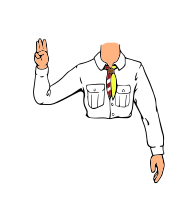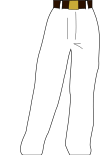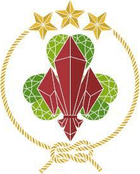Latvijas Skautu un Gaidu Centrālā Organizācija
| Latvijas Skautu un Gaidu Centrālā Organizācija | |||
|---|---|---|---|
|
Latvian Scout and Guide Central Organisation | |||
| Headquarters | Kalpaka bulv. 10-18 | ||
| Location | Riga | ||
| Country | Latvia | ||
| Founded | 1917/1990 | ||
| Membership | 759 | ||
| Affiliation | World Association of Girl Guides and Girl Scouts, World Organization of the Scout Movement | ||
|
| |||
|
Website http://www.skauti.lv | |||

   | |||
Latvijas Skautu un Gaidu Centrālā Organizācija, (Latvian Scout and Guide Central Organisation), the primary national Scouting and Guiding organization of Latvia is a member of both the World Association of Girl Guides and Girl Scouts and the World Organization of the Scout Movement. The coeducational Latvijas Skautu un Gaidu Centrālā Organizācija serves 759 members as of 2011 (466 Scouts[1] and 293 Guides).
History
The Latvian Scouting program is based on the principles and methods created by Robert Baden-Powell, later forbidden by the Soviet government in 1940.[2] The first Scout troop in Latvia was established on April 17, 1917 under Tsarist Russia, by Arvīds Bredermanis and other Scouts from Tartu, Estonia, followed by several other Scout troops in the Riga area. The official founding of Scouting in Latvia is counted to be 1917.
The Latvian Scout Organization Latvijas Skautu Organizācija was established in 1921, and Latvia was a founding member of the World Organization, from 1922 to 1940. Guiding was started in Latvia in 1921 under the Latvian Youth Organizations. In early 1922 Latvijas Gaidu Centrālā Organizācija was set up, and Girl Guiding was permitted to operate as an independent organization. Latvia enjoyed a visit from Olave Baden-Powell, World Chief Guide, in 1933 and had a very active Guiding movement until it was banned in 1940.[3]
In 1940, after the Soviet occupation of Latvia, a special officer was appointed by the communists to abolish Scouting. Scouting continued unofficially and underground, operating without uniforms and in the forests to avoid detection. In 1941, the Communists killed the Latvian Scout founder and President, General Kārlis Goppers (1876–1941). The former Scout Commissioner for Latvia, Valdemārs Klētnieks, fled to the United States as a refugee after World War II.[4] With the fall of communism, Scouting reemerged, and in 1989, the first Latvian Scout and Guide camp was organized. In 1990, Latvian Scouts held their fifth National Jamboree, "Renewal" and invited several other countries to participate.
Latvijas Skautu un Gaidu Centrālā Organizācija (the Latvian Scout and Guide Central Organization, LSGCO) rejoined the World Organization of the Scout Movement (WOSM) in 1993, as well as the World Association of Girl Guides and Girl Scouts. There were 452 registered Scouts (as of 2008)[5] and 984 registered Guides (as of 2003). In 2000 and 2001 Latvijas Skautu un Gaidu Centrālā Organizācija and Pfadfinder und Pfadfinderinnen Österreichs worked together on the WAGGGS project „Food & Nutrition“ and Latvian Scouts and Guides took part in the Austrian National Jamboree in 2001.[6][7][8][9]
Ideals and principles
The organization is based on the following principles:
- Duty to God-encourage the fulfillment of their religion.
- Duty to others-to help other people, your nation and country
- Develop friendship and cooperation among all nations.
- Duty to oneself-being responsible for ones development.
The Scout and Guide Motto is Esi Modrs, translating as Be Watchful in Latvian, the response to which is (masculine) Arvien Modrs!, and (feminine), Arvien Modra!, Always Watchful! The Little Fire Motto is Centīšos!, I will try. The Latvian noun for a single Scout is Skauts.
Guide Oath (Gaidu solijums)
- Ar goda vārdu solos visiem spēkiem
- censties: būt uzticīga Dievam un
- Latvijai, palīdzēt tuvākajiem katrā
- brīdi, pildīt gaidu likumus.
- On my honor, I will do my best; to do my duty to God and Latvia, to help other people as all times and to obey the Scout/Guide Law.
Scout Law
- A Scout is trustworthy
- A Scout is loyal to fatherland
- A Scout is self-denying and helpful
- A Scout is friendly and tolerant
- A Scout is courteous
- A Scout is a friend to nature
- A Scout is obedient
- A Scout is alert in hardships
- A Scout is active and thrifty
- A Scout is clean in thoughts, words and deeds
Program sections
- Mazskauts-Cub Scouts/Guntiņa "Little Fire" or Brownies-7 to 11
- Skauts or Scouts/Gaida or Guides-12 to 16
- Lielgaida or Rovers/Rangers-over 16
Gaidu likumi (Guide Law)
- Gaida ir patiesa
- Gaida ir uzticīga Tēvijai
- Gaida ir pašaizliedzīga un palīdzīga
- Gaida ir draudzīga un iecietīga
- Gaida ir pieklājīga
- Gaida ir dabas draudzene
- Gaida ir paklausīga
- Gaida ir moža grūtībās
- Gaida ir darbīga un taupīga
- Gaida ir tīra domās, vārdos un darbos.
Little Fire Promise
- Censties gribu guntiņa
- Paklausīga, laba būt,
- Lai mirdz mans tikumiņš
- Kā mirdz spoža uguntiņa
Little Fire Law
- Guntiņa klausa vecāko
- Guntiņa valda sevi
Emblem
The membership badge of Latvijas Skautu un Gaidu Centrālā Organizācija Scout emblem incorporates three stars of the coat of arms of Latvia, which embody the idea of the inclusion of historical districts (Vidzeme, Latgale and combined Courland-Semigalia (Kurzeme-Zemgale) into the united Latvia.
See also
References
- ↑ "Triennal review: Census as at 1 December 2010" (PDF). World Organization of the Scout Movement. Archived from the original (PDF) on 2012-08-31. Retrieved 2011-01-13.
- ↑ John S. Wilson (1959), Scouting Round the World. First edition, Blandford Press. p. 159
- ↑ John S. Wilson (1959), Scouting Round the World. First edition, Blandford Press. p. 159
- ↑ Goodman, E. Urner (1965). The Building of a Life. St. Augustine, Fla.: Standard Printing.
Goodman, who was National Program Director of the Boy Scouts of America (BSA) in the 1940s, and his wife took in the exiled Latvian Scout Commissioner, Valdemārs Klētnieks, and his family at their Vermont farm. As of 2006, Klētnieks' grandson and great-grandson are members of the BSA and his daughter lives in Riga. - ↑ "Triennial Report 2005-2008" (PDF). World Organization of the Scout Movement. Archived from the original (PDF) on 2008-09-09. Retrieved 2008-07-13.
- ↑ Inge Pamminger (1999). "Partnerland Lettland". PPÖ-Brief (in German). Pfadfinder und Pfadfinderinnen Österreichs. 3/1999: 29–30.
- ↑ Irene Rojnik;Marlies Honnegger-Jünnemann (2000). "Partnerschaft:Lettland-Luxemburg-Österreich". PPÖ-Brief (in German). Pfadfinder und Pfadfinderinnen Österreichs. 3/2000: 22.
- ↑ Christa Stadler (2000). "Jugendtreffen Österreich-Lettland". PPÖ-Brief (in German). Pfadfinder und Pfadfinderinnen Österreichs. 2/2000: 19.
- ↑ b.open daily (2001). "lagerplan/map". b.open daily (in German and English). Pfadfinder und Pfadfinderinnen Österreichs.
Further reading
- World Association of Girl Guides and Girl Scouts, World Bureau (2002), Trefoil Round the World. Eleventh Edition 1997. ISBN 0-900827-75-0
